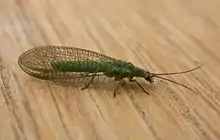| Mallada signatus | |
|---|---|
 | |
| Mallada signatus | |
| Scientific classification | |
| Domain: | Eukaryota |
| Kingdom: | Animalia |
| Phylum: | Arthropoda |
| Class: | Insecta |
| Order: | Neuroptera |
| Family: | Chrysopidae |
| Genus: | Mallada |
| Species: | M. signatus |
| Binomial name | |
| Mallada signatus Schneider, 1851 | |
| Synonyms | |
|
Mallada alcatoa, Banks, 1943 Chrysopa alcatoa, Banks, 1943[1] Mallada signata, Schneider, 1851 | |
Mallada signatus, commonly known as the green lacewing[2] is a species of insect described by Wilhelm Gottlieb Schneider in 1851.[3]
It is one of the species most commonly found in southern Australia.[4]
They closely resemble Plesiochyrsa ramburi, however, the late instar larva and adults of Mallada signatus are smaller, with minimal dark markings on the head of the adults.[5]
They can be negatively effected by feeding on prey which has been in contact with neem oil.[6]
References
- ↑ "Species: Mallada signatus". bie.ala.org.au. Atlas of Living Australia.
- ↑ "Green lacewing: general predator" (PDF). The Good Bug Book.
- ↑ "Mallada signatus (Schneider, 1851) | COL". www.catalogueoflife.org.
- ↑ Horne, P.A.; New, T.R.; Papacek, D. (2001). "Preliminary notes on Mallada signatus (Chrysopidae) as a predator in field crops in Australia". Lacewings in the Crop Environment. Cambridge University Press. pp. 395–397. ISBN 978-0-521-77217-4.
- ↑ Hopkinson, Jamie (20 May 2019). "Taking a closer look at green lacewings | The Beatsheet". thebeatsheet.com.au.
- ↑ Qi, Baoying; Gordon, Gordh; Gimme, Walter (October 2001). "Effects of Neem-Fed Prey on the Predacious Insects Harmonia conformis (Boisduval) (Coleoptera: Coccinellidae) and Mallada signatus (Schneider) (Neuroptera: Chrysopidae)". Biological Control. 22 (2): 185–190. doi:10.1006/bcon.2001.0965.
External links
This article is issued from Wikipedia. The text is licensed under Creative Commons - Attribution - Sharealike. Additional terms may apply for the media files.